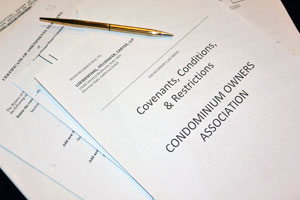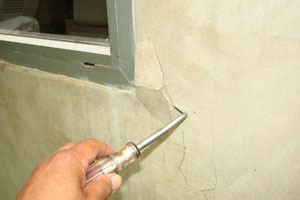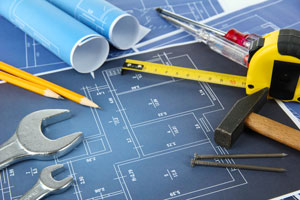By: David A. Loewenthal, Esq.
Environmental quality of indoor air has received increasing attention over the last decade as the nation has become more informed about the dangers of indoor pollution. As with noise and pets, issues regarding indoor pollutants are a constant source of disputes within community associations. Though this can occur in single family homes, it is generally most apparent in attached dwellings such as condominium units where pollutants may be flowing through common area vents, ceilings and walls. Below is brief overview of the problems encountered with two common indoor pollutants, mold and smoke, as well as a discussion on neighbor to neighbor disputes that may result.
MOLD[1]
Through a simple internet search, just about anyone can quickly become well versed in the possible dangers of mold and all associated health risks and consequences, no matter how remote. Mold growth may result from water penetration through the roofs, exterior walls, pipes or any other component which are usually maintained by the homeowners association. As such, Associations are considered to have potential liability because they have the ability to mitigate water intrusion, as well as to aggravate mold problems through the abatement procedures, or lack thereof. In response, the Association must prepare and plan in order to prevent a mold disaster before it occurs.
Avoiding a mold disaster is an obtainable goal if the Association follows some general guidelines:
Awareness and Prevention: Avoiding mold problems starts with awareness and prevention. Non toxic mold in small quantities is inevitable in all indoor atmospheres, however, precautionary measures should be taken to prevent mold from infiltrating an Association. One of the most important preventive measures Associations can take is to locate and repair all sources of water intrusion, including any defective roofing, common area plumbing leaks, exterior wall leaks, and other sources of water intrusion from common area components.
Insurance: The association should immediately get in touch with its insurer the first time anything resembling a mold related complaint comes from a unit owner. The insurer has a duty to deal with mold claims quickly and correctly. Policyholders are often discouraged from contacting their insurers. Reasons for this discouragement range from the insurers poor handling or non-responsive attitude toward a claim to a fear of non-coverage due to a so-called Amold exclusion@ in the association=s insurance policy, as well as the fear of being non-renewed. However, even if mold is specifically excluded by the policy, there is still a chance for coverage. Many courts have held that ensuing loss provisions contained in policies with mold exclusions allow for coverage of mold originating from a loss which is covered under the policy. In other words, if covered water damage causes mold, then the resulting mold damage may also be covered.
Remediaton: Regardless of the scope and degree of the problem, all allergic and toxic mold should be removed and the source of the water must be repaired. A Certified Industrial Hygienist can be hired to test both the affected surfaces as well as the air in the areas affected by the mold. The hygienist will recommend a course of action for the remediation of the mold. At that time, the Association would be wise to hire a mold remediation company that has both the knowledge and equipment to properly remediate the mold. The hygienist should return after the remediation company has completed the work and do sample tests again in order to clear the area and certify that the mold species and counts in the area are acceptable. The costs for mold testing by a hygienist, as well as the remediation of the mold, are high, however ignoring a mold problem can be much more costly.
Though the costs may be high and no one likes to have to pay higher assessments, boards of directors are charged with the responsibility to maintain the common areas in the community and must do so in order to carry out their fiduciary responsibility. Most importantly, a board of directors must address the mold issues that may exist in the community and take proper steps to resolve the matter. It will not help to ignore the problem if it exists since the mold menace will not just go away.
SMOKE
Cigar and cigarette smoke is not only a potential health risk, but its penetrating odor is considered by many to be offensive and noxious. As such, it has also been a source of dispute between neighbors and homeowners association. While a smoker may smoke only in his or her unit, the smoke may waft into a neighboring unit via open windows or common area vents. Smoke may aggravate the affected homeowners respiratory problems and permeate furniture, clothing, and drapes.
The problems with smoke have not escaped the attention of the legislature. In 2003, AB210, was introduced to the legislature. The bill proposed to prohibit the smoking of tobacco products in common areas of any common interest development, including planned unit developments and condominium projects, and within individual condominium units under certain circumstances, and makes not only homeowners but associations, management companies, and individual managers potentially liable. It also made it a crime punishable by fine.[2]
The bill also proposed to inhibit smoking in individual condominium units and in essence created a private right of action for nuisance for condominium owners affected by smoke. The proposed law provided that the exposed owner may bring a nuisance cause of action not only against the smoker but also against any person who permits or fails to control that nuisance.[3] Although the bill was eventually dropped, do not be surprised if bill resurfaces in the near future and in a similar form.
Without the intervention of the legislature, the Association and members may still rely on their governing documents to prevent and resolve smoking and smoke disputes:
Adopt Rules and Regulations: Most governing documents allow an Association to adopt reasonable rule and regulations regarding the use of the common area. If smoking is a problem, the Association may decide to prohibit smoking in the common areas or designate certain common areas as non-smoking to protect those sensitive to smoke.
Nuisances: The CC&Rs should also contain a nuisance provision which prohibit illegal, offensive and obnoxious actions or noxious odors from any source which in any way interfere with a resident=s quiet enjoyment of the property. While most governing documents do not contain smoke specific nuisance provisions, the Association or affected homeowner may bring a nuisance cause of action for offensive and noxious smoke against the offending and responsible parties. Finally, most governing documents authorize the Board of Directors to seek injunctive relief should it determine that any action, odor or conduct constitutes a nuisance.
NEIGHBOR DISPUTES[4]
If a homeowner believes that a neighbor is violating the Association’s governing documents by causing or introducing mold, smoke or other pollutants, that homeowner has a right to enforce these documents directly against the neighbor. Assuming that the owner decides to enforce the issue, the next step is how to best deal with this issue. Generally speaking, since both the aggrieved party, as well as the aggravating party are neighbors, it is my recommendation that if this can be resolved in an informal manner, it should in fact be accomplished this way. Specifically, discussions amongst rational neighbors generally should alleviate any problem.
However, for those neighbors who either are unwilling to remedy the problem or unable to remedy the issue voluntarily, the aggrieved homeowner could seek the intervention of the homeowners association=s Board to also attempt to enforce compliance. If the Association is charged with such duties, a failure to take action could be a breach of the Board of Directors duties and obligations. This would have to be viewed on a case by case basis. If the neighbor is unwilling to comply with a legitimate request that is creating the dispute, the aggrieved homeowner may make a demand for Alternative Dispute Resolution (ADR) pursuant to Civil Code Sections 1369.510 et seq. ADR allows for either mediation, binding arbitration or non-binding arbitration. An aggravating party, when served, has thirty (30) days in which to either accept or reject or not respond to the request. A non-response is the same as a rejection. If there is a non-response or rejection, the aggrieved party may then proceed forward in filing a civil action. However, proceeding with a lawsuit should be a last resort and only taken if no reasonable resolution can be reached on a more voluntary level.
Sometimes the only way to obtain a violating neighbors attention is to threaten and sometimes carry out either discipline and/or a fine. Homeowners associations should include within their rules and regulations a written fine policy that specifically spells out for all of the owners the ramifications for violations of the Association’s governing documents. Generally, but not always, such written policies will provide a warning letter for a first offense and then a stepped up fining policy for each continuing violation. It should be noted that fines are not assessments and therefore cannot be the subject of a lien or foreclosure action. However, an Association can file an action against an owner in small claims court or superior court to collect on such fines.
Again, the above represents types of events that create disputes between neighbors and homeowner associations, though it is clearly not an exhaustive list. Attempts to work things out amongst neighbors is clearly the best approach to settling disputes; however, if such reasonable means are unsuccessful, then an aggrieved neighbor should pursue Alternative Dispute Resolution pursuant to Civil Code Section 1369.510 et seq., and if that fails and the aggravation is of such a significance that the homeowner can no longer tolerate it, then the courts are open to them.
Neighbors should always recall that they are living within a homeowners association community and as such they are conventing to be bound by certain restrictions and rules. If such restrictions and rules are not acceptable to a homeowner then possibly living in a homeowners association is a not a good choice for them.


